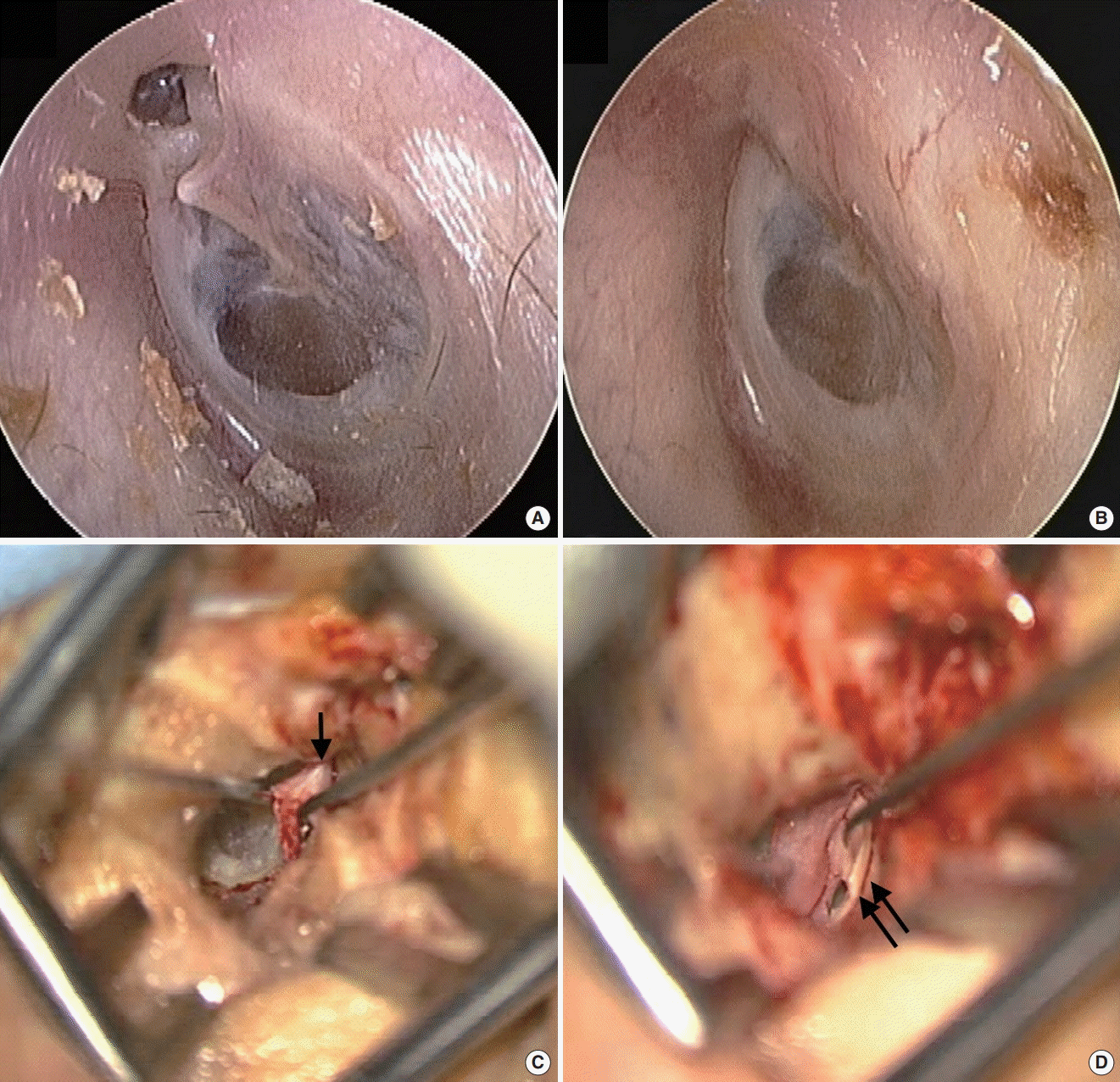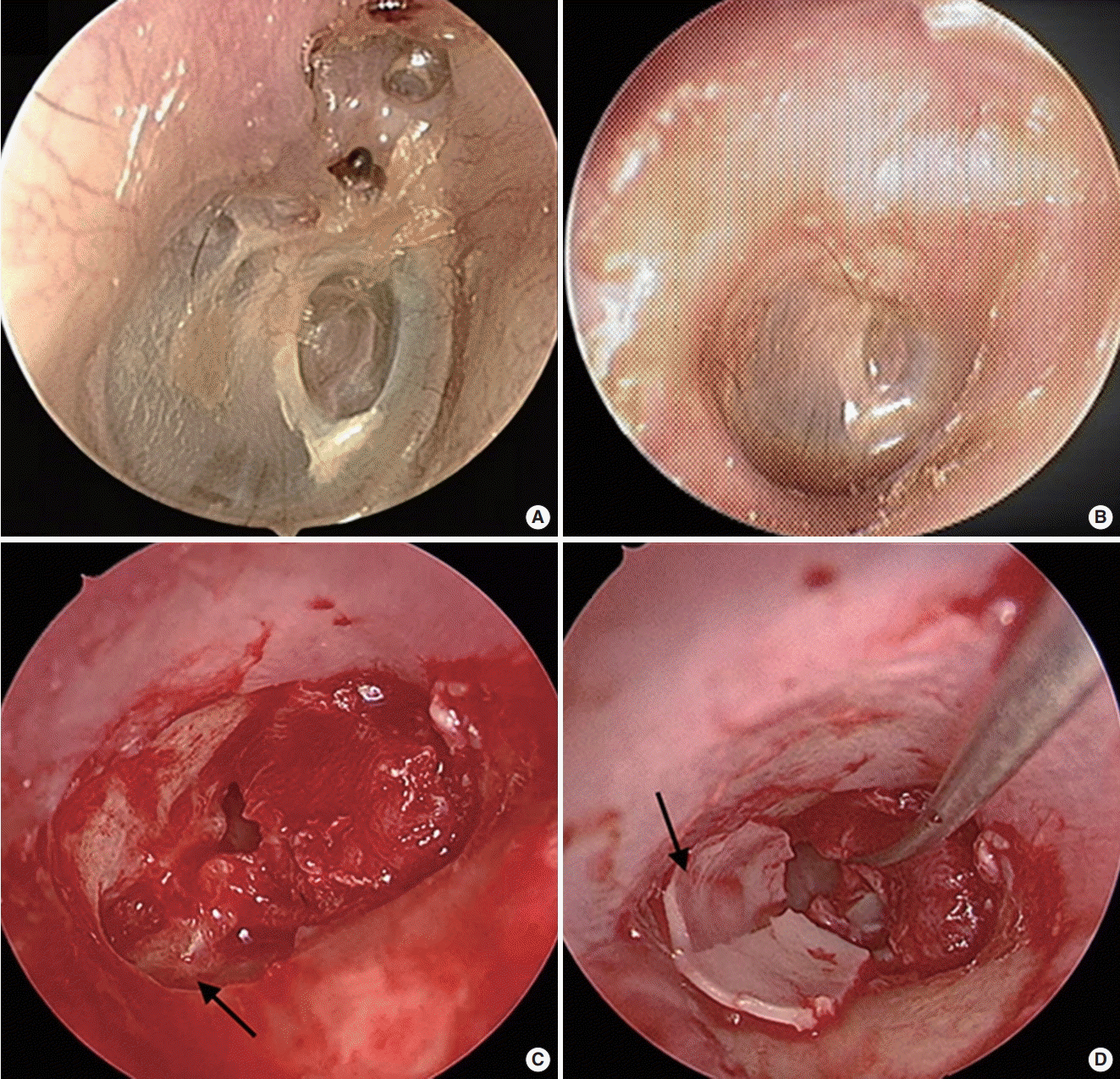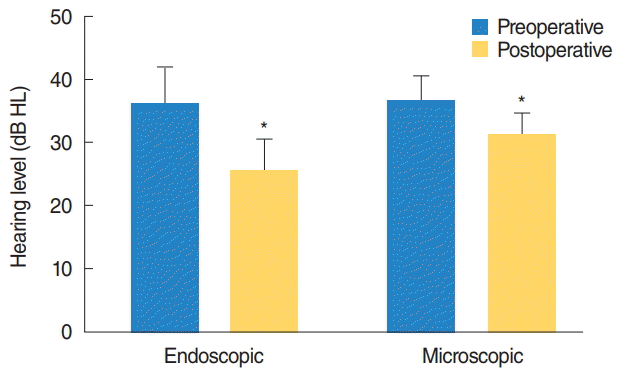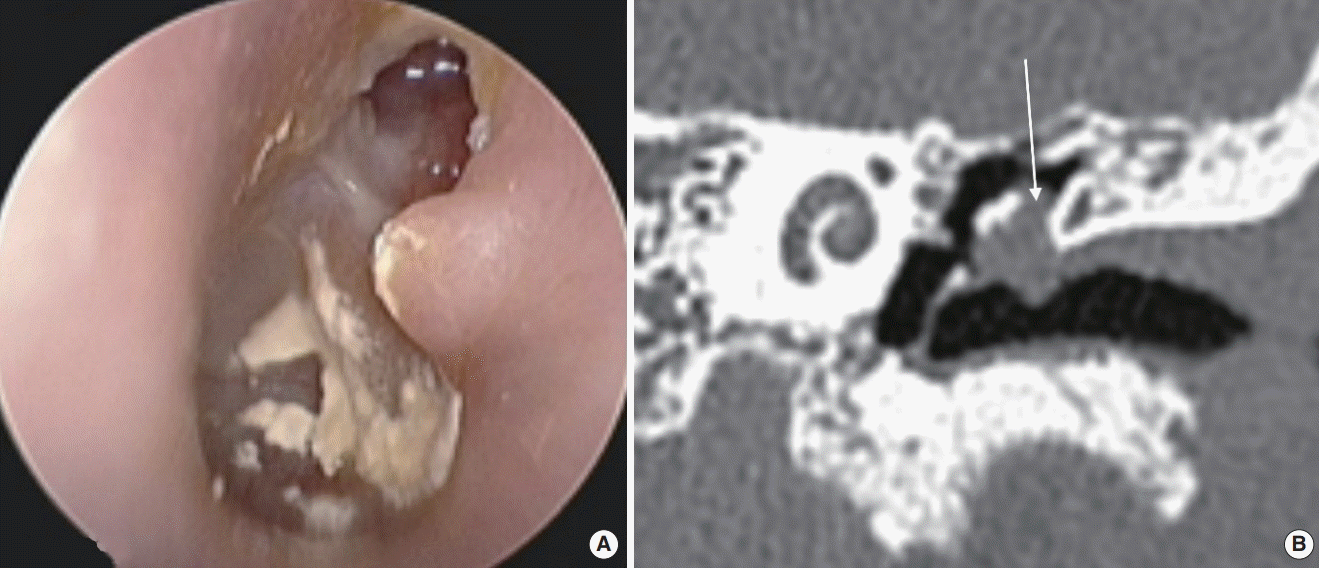INTRODUCTION
MATERIALS AND METHODS
 | Fig. 2.Microscopic approach for attic cholesteatoma in patient who suffered from intermittent otorrhea and otalgia (case 16 in Table 1). (A) Attic destruction was observed on preoperative examination of the left tympanic membrane. (B) Postoperative examination shows the tympanic membrane with clear attic area. Intraoperative findings show the elevated tympanomeatal flap (arrow) after Lempert endaural incision II and Lempert I incision (C), and inserted cartilage for reconstruction of the attic area (double arrows, D). |
 | Fig. 3.Endoscopic approach for attic cholesteatoma in patient who suffered from hearing loss and intermittent otorrhea (case 10 in Table 1). (A) Attic destruction was observed on preoperative examination of the right tympanic membrane. (B) Postoperative examination shows a clear attic. (C) Endoscopically, the head of the malleus is shown (arrow) after elevation of the tympanomeatal flap. (D) After removal of the cholesteatoma, the attic was reconstructed with cartilage (arrow). |
RESULTS
Table 1.
| Case | Use of endoscope | Age/sex | Stagea) | Operation time (hr) | Anesthesia | Ossiculoplasty | Lempert incision | Preop AC (dB) | Postop AC (dB) | Preop ABG (dB) | Postop ABG (dB) | ABG closure (dB) | Recurrence | Follow-up month |
|---|---|---|---|---|---|---|---|---|---|---|---|---|---|---|
| 1 | Yes | 47/M | 2 | 1.3 | G | No | I | 27.5 | 23.75 | 17.5 | 10 | 7.5 | No | 13.9 |
| 2 | Yes | 60/F | 1b | 2.1 | G | Yes | I | 67.5 | 32.5 | 28.75 | 7.5 | 21.25 | No | 19.6 |
| 3 | Yes | 26/F | 1b | 1.1 | L | No | I | 18.75 | 7.5 | 15 | 0 | 15 | No | 19.9 |
| 4 | Yes | 23/F | 1b | 2 | L | No | I | 8.75 | 3.75 | 7.5 | 0 | 7.5 | No | 23.0 |
| 5 | Yes | 61/F | 1b | 1.2 | L | No | I | 51.25 | 43.75 | 17.5 | 12.5 | 5 | No | 26.0 |
| 6 | Yes | 52/M | 1b | 1.4 | L | No | I | 26.25 | 30 | 8.75 | 16.25 | –7.5 | No | 41.7 |
| 7 | Yes | 28/M | 2 | 2.1 | G | Yes | I | 47.5 | 23.75 | 28.75 | 15 | 13.75 | No | 10.8 |
| 8 | Yes | 38/M | 1b | 1.7 | G | Yes | I | 48.75 | - | 33.75 | - | - | No | 5.6 |
| 9 | Yes | 65/M | 2 | 2.3 | G | Yes | I | 43.75 | 47.5 | 0 | 12.5 | –12.5 | No | 9.0 |
| 10 | Yes | 35/F | 1b | 1.3 | G | No | I | 21.25 | 17.5 | 15 | 5 | 10 | No | 28.0 |
| 11 | No | 39/M | 2 | 1.5 | L | No | II | 43.75 | 37.5 | 33.75 | 27.5 | 6.25 | No | 30.2 |
| 12 | No | 69/F | 2 | 1.3 | G | No | II | 46.25 | 42.5 | 10 | 6.25 | 3.75 | No | 27.8 |
| 13 | No | 44/M | 2 | 2 | G | Yes | II | 36.25 | 22.5 | 17.5 | 12.5 | 5 | No | 30.7 |
| 14 | No | 62/F | 2 | 1.5 | G | No | II | 42.5 | 38.75 | 18.75 | 13.75 | 5 | No | 30.7 |
| 15 | No | 47/F | 2 | 3 | G | No | II | 28.75 | 27.5 | 1.25 | 8.75 | –7.5 | No | 36.1 |
| 16 | No | 21/M | 1b | 1.3 | G | No | II | 20 | 28.75 | 5 | 15 | –10 | No | 37.9 |
| 17 | No | 58/F | 2 | 2 | G | Yes | II | 45 | 22.5 | 28.75 | 12.5 | 16.25 | No | 38.9 |
| 18 | No | 43/M | 1b | 2 | L | No | II | 16.25 | 16.25 | 0 | 3.75 | –3.75 | No | 61.0 |
| 19 | No | 65/F | 2 | 1.8 | L | No | II | 31.25 | 25 | 15 | 15 | 0 | No | 53.2 |
| 20 | No | 50/M | 1b | 1.5 | L | No | II | 56.25 | 51.25 | 6.25 | 3.75 | 2.5 | No | 64.0 |
Preop, preoperative; AC, air conduction; Postop, postoperative; ABG, air-bone gap; G, general; L, local.
a) Stage according to the classification of Tono et al. [2].
 | Fig. 4.Preoperative and postoperative air conduction hearing levels (HL) of the patients. HL was improved postoperatively in both groups (asterisk). There was no statistically significant difference of improvement between endoscopic and microscopic approaches (P=0.13). |
Table 2.
| Variable | Endoscopic surgery (n=10) | Microscopic surgery (n=10) |
|---|---|---|
| Mean age (yr) | 43.5 | 49.8 |
| Sex (male:female) | 5:5 | 5:5 |
| Anesthesia (general:local) | 6:4 | 6:4 |
| Stage (1b:2)a) | 7:3 | 3:7 |
| Air conduction PTA (dB HL), mean±SE | ||
| Preoperative | 36.13±5.8 | 36.63±4.0 |
| Postoperative | 25.56±4.9 | 31.25±3.4 |
| Air-bone gap (dB HL), mean±SE | ||
| Preoperative | 17.25±3.4 | 13.63±3.6 |
| Postoperative | 8.75±2.1 | 11.88±2.2 |
| Tympanoplasty type I:ossiculoplasty | 6:4 | 7:2b) |
| Operation time (hr), mean±SD | 1.65±0.4 | 1.79±0.5 |
| Recurrent:residual disease | 0:0 | 0:0 |
| Mean follow-up period (mo) | 19.75 | 41.05 |
a) Stage according to the classification of Tono et al. [2].




 PDF
PDF Citation
Citation Print
Print




 XML Download
XML Download